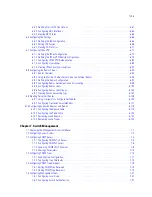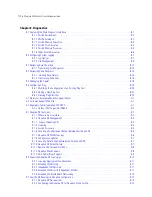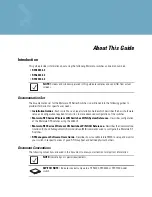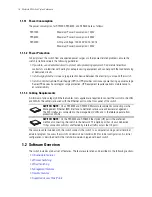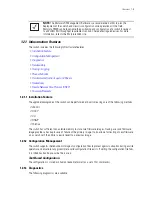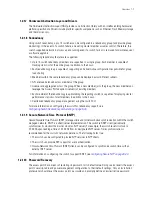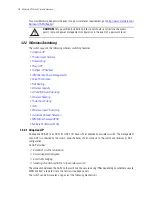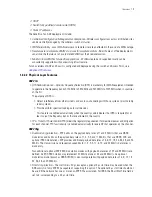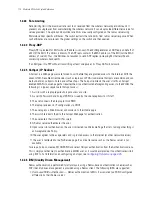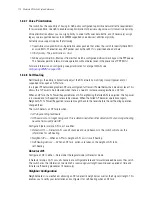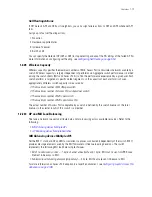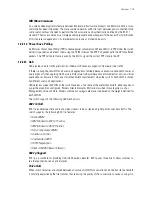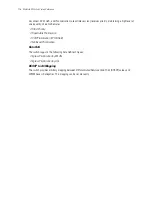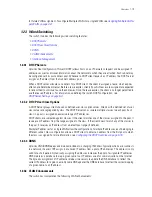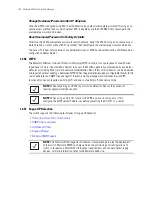
Overview
1-9
• DHCP
• Switch fully qualified domain name (FQDN)
• Static IP addresses
The benefits of an AAP deployment include:
•
Centralized Configuration Management & Compliance
- Wireless configurations across distributed sites
can be centrally managed by the wireless switch or cluster.
•
WAN Survivability
- Local WLAN services at a remote sites are unaffected in the case of a WAN outage.
•
Securely extend corporate WLAN's to stores for corporate visitors
- Small home or office deployments
can utilize the feature set of a corporate WLAN from their remote location.
•
Maintain local WLAN's for specific applications
- WLANs created and supported locally can be
concurrently supported with your existing infrastructure.
For an overview of AAP and how it is configured and deployed using the switch and Access Point, see
Adaptive AP Overview
.
1.2.2.2 Physical Layer Features
802.11a
•
DFS Radar Avoidance
–
Dynamic Frequency Selection
(DFS) is mandatory for WLAN equipment intended
to operate in the frequency bands 5150 MHz to 5350 MHz and 5470 MHz to 5725 MHz when in countries
of the EU.
The purpose of DFS is:
• Detect interference from other systems and avoid co-channeling with those systems (most notably
radar systems).
• Provide uniform spectrum loading across all devices.
This feature is enabled automatically when the country code indicates that DFS is required for at
least one of the frequency bands that are allowed in the country.
•
TPC
–
Transmit Power Control
(TPC) meets the regulatory requirement for maximum power and mitigation
for each channel. TPC functionality is enabled automatically for every AP that operates on the channel.
802.11bg
•
Dual mode b/g protection
– ERP builds on the payload data rates of 1 and 2 Mbit/s that use DSSS
modulation and builds on the payload data rates of 1, 2, 5.5, and 11 Mbit/s, that use DSSS, CCK, and
optional PBCC modulations. ERP provides additional payload data rates of 6, 9, 12, 18, 24, 36, 48, and 54
Mbit/s. The transmission and reception capability for 1, 2, 5.5, 11, 6, 12, and 24 Mbit/s data rates is
mandatory.
Two additional optional ERP-PBCC modulation modes with payload data rates of 22 and 33 Mbit/s are
defined. An ERP-PBCC station may implement 22 Mbit/s alone or 22 and 33 Mbit/s. An optional
modulation mode (known as DSSS-OFDM) is also incorporated with payload data rates of 6, 9, 12, 18,
24, 36, 48, and 54 Mbit/s.
•
Short slot protection
– The slot time is 20 µs, except an optional 9 µs slot time may be used when the
BSS consists of only ERP STAs capable of supporting this option. The optional 9 µs slot time should not
be used if the network has one or more non-ERP STAs associated. For IBSS, the Short Slot Time field is
set to 0, corresponding to a 20 µs slot time.
Summary of Contents for RFS Series
Page 1: ...M Motorola RFS Series Wireless LAN Switches WiNG System Reference Guide ...
Page 10: ...TOC 8 Motorola RF Switch System Reference Guide ...
Page 56: ...2 8 Motorola RF Switch System Reference ...
Page 334: ...5 52 Motorola RF Switch System Reference 2 Select the MU Status tab ...
Page 510: ...7 32 Motorola RF Switch System Reference Guide ...
Page 534: ...8 24 Motorola RF Switch System Reference Guide ...
Page 570: ...C 14 Motorola RF Switch System Reference Guide ...
Page 589: ......

